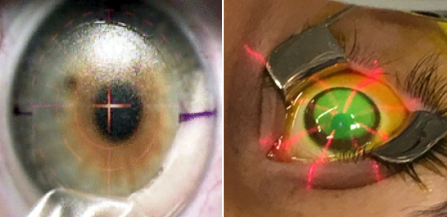 |
Conventional LASIK actually outperformed LASIK Xtra in high myopes in this study. Click image to enlarge. |
Corneal collagen crosslinking (CXL) has been proven effective in slowing keratoconus and postsurgical ectasia. Thus, an approach called LASIK Xtra, which involves simultaneous accelerated CXL and LASIK, seems intuitively to be a good prophylactic option for populations at relatively high risk for ectasia. To further evaluate the necessity of adjuvant CXL in LASIK, researchers recently performed LASIK Xtra and conventional LASIK randomly in highly myopic fellow eyes and followed them for 24 months.
Twenty-five patients with high myopia were treated randomly with LASIK Xtra in one eye and conventional LASIK in the other. A 24-month follow-up was conducted, and the main outcome measures included uncorrected distance visual acuity (UDVA), corrected distance visual acuity, manifest refraction spherical equivalent and corneal tomography.
The UDVA was 0.09±0.15logMAR in the LASIK Xtra group, which was significantly worse than that in the conventional LASIK group one day postoperatively, but the difference became nonsignificant from one week after surgery. The efficacy index was 0.88±0.18logMAR in the LASIK Xtra eyes and 0.99±0.13logMAR in the conventional LASIK eyes at 24 months.
Throughout the follow-up period, a slight myopic shift in the manifest refraction spherical equivalent and keratometry values was observed in both groups without significant intergroup differences. The coefficient of determination was 0.9982 in the LASIK Xtra eyes and 0.9987 in the conventional LASIK eyes. The corneal density was significantly higher, and demarcation lines were visible in the first six months in LASIK Xtra eyes, but both signs of crosslinking gradually disappeared during follow-up. No severe complications were detected in either group.
Concerning efficacy, LASIK Xtra patients may perform slightly worse shortly after surgery. This cohort had inferior refractive outcomes one day after surgery, which did not recover until one week postoperatively.
“While in contrast to previous studies, which generally reported nonsignificant lower efficacy index in the LASIK Xtra group, we observed significantly lower efficacy index in LASIK Xtra eyes at 24 months,” the authors explained in their paper on the study. “We supposed that the worse performance following LASIK Xtra may be due to the fact that prophylactic accelerated CXL only increases the tissue reaction but fails to sufficiently strengthen the cornea as therapeutic CXL.”
In conclusion, LASIK Xtra showed comparable safety and predictability with conventional LASIK for high myopia. However, no superior stability was observed in LASIK Xtra eyes over conventional LASIK eyes, which was the initial motivation for combining CXL with the standard LASIK procedure.
“In addition, simultaneous CXL may weaken the advantages of LASIK, such as rapid visual rehabilitation, and increase relift difficulty for enhancement,” the authors noted. “We therefore tend to regard CXL as a treatment for post-LASIK ectasia rather than a prophylaxis unless more compelling evidence with long-term follow-up can be published.”
Dong R, Zhang Y, Yuan Y, et al. A prospective randomized self-controlled study of LASIK combined with accelerated cross-linking for high myopia in Chinese: 24-month follow-up. BMC Ophthalmol. June 24, 2022. [Epub ahead of print]. |


